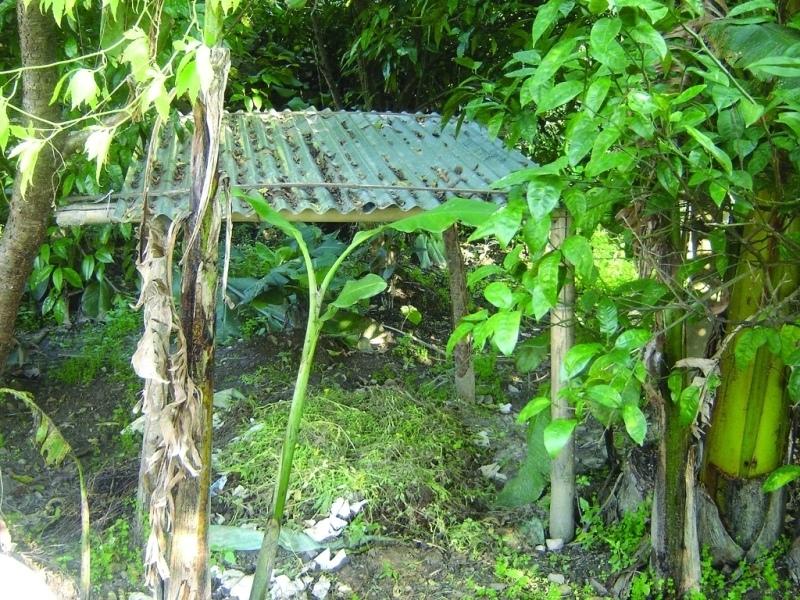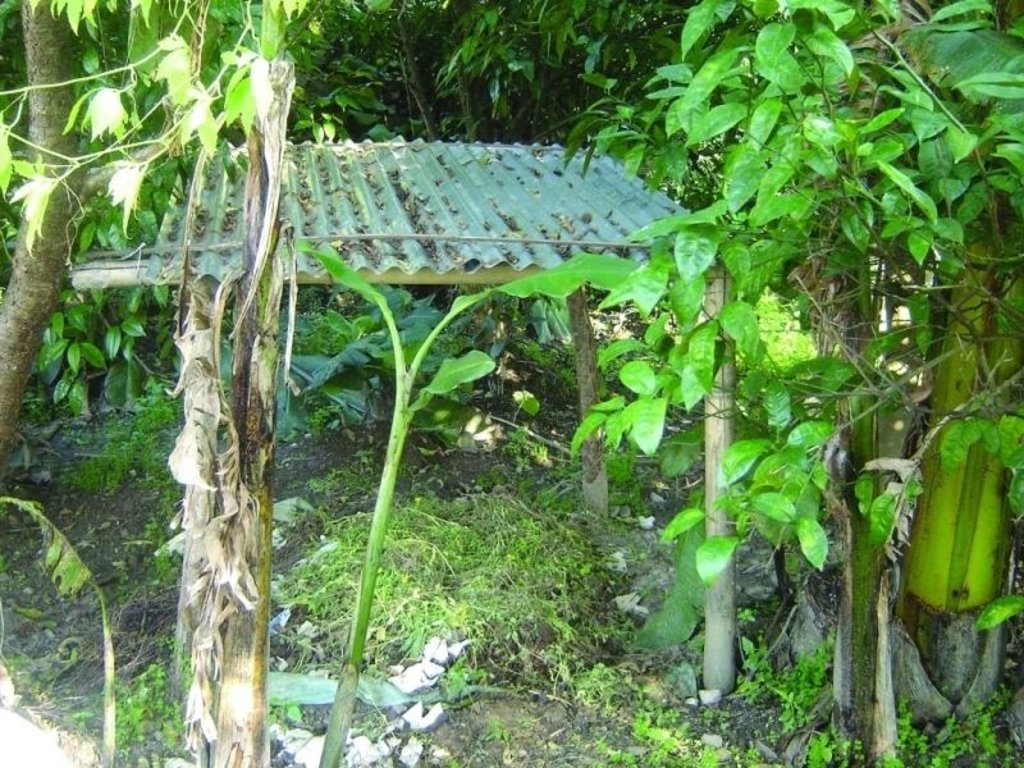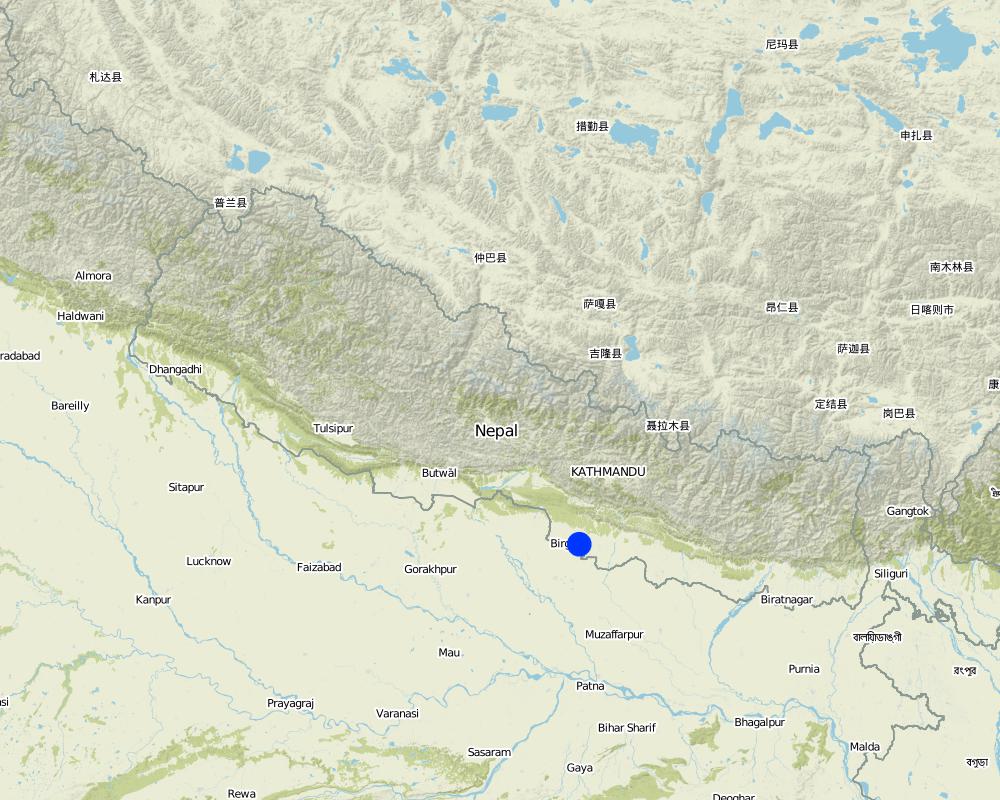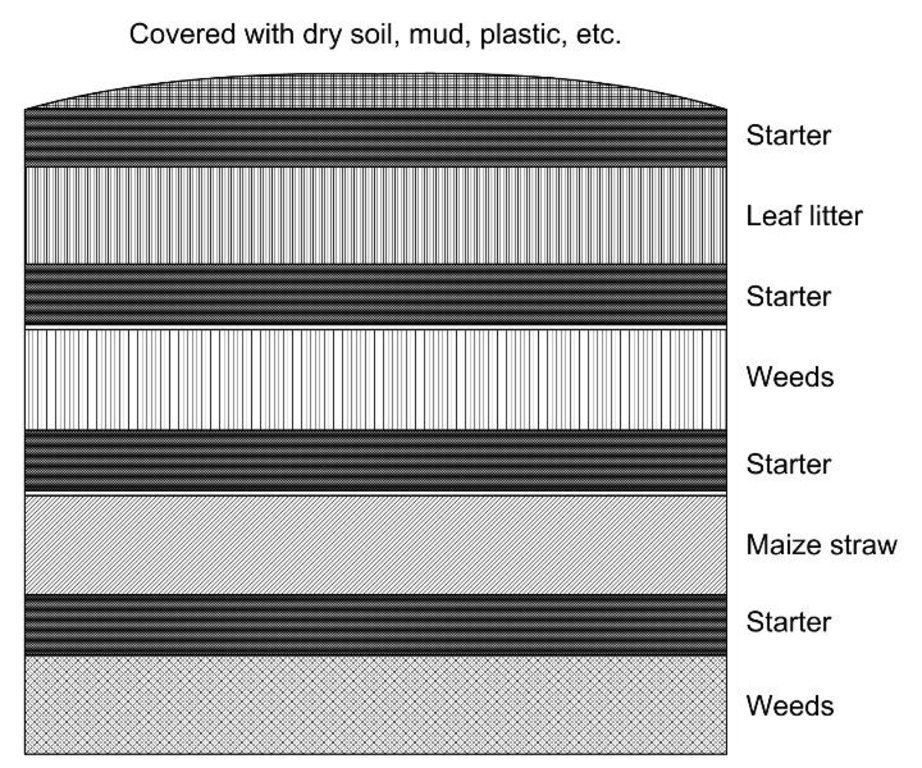Improved compost preparation [尼泊尔]
- 创建:
- 更新:
- 编制者: Richard Allen
- 编辑者: –
- 审查者: David Streiff, Alexandra Gavilano
Sudhariyeko compostmal nirman (Nepali)
technologies_1750 - 尼泊尔
查看章节
全部展开 全部收起1. 一般信息
1.2 参与该技术评估和文件编制的资源人员和机构的联系方式
SLM专业人员:
Director
Soil Management Directorate, Department of Agriculture
尼泊尔
SLM专业人员:
Team Leader
Sustainable Soil Management Programme
尼泊尔
有助于对技术进行记录/评估的项目名称(如相关)
Sustainable Soil Management Programme, Nepal (SSMP)有助于对技术进行记录/评估的机构名称(如相关)
Department of Agriculture, Soil Management Directorate, Hariharbhawan Lalitpur (doasoil) - 尼泊尔有助于对技术进行记录/评估的机构名称(如相关)
HELVETAS (Swiss Intercooperation)1.3 关于使用通过WOCAT记录的数据的条件
编制者和关键资源人员接受有关使用通过WOCAT记录数据的条件。:
是
1.5 参考关于SLM方法(使用WOCAT记录的SLM方法)的调查问卷

Farmer field schools on integrated plant nutrient systems [尼泊尔]
Participatory and collaborative learning through the farmer field school approach
- 编制者: Richard Allen
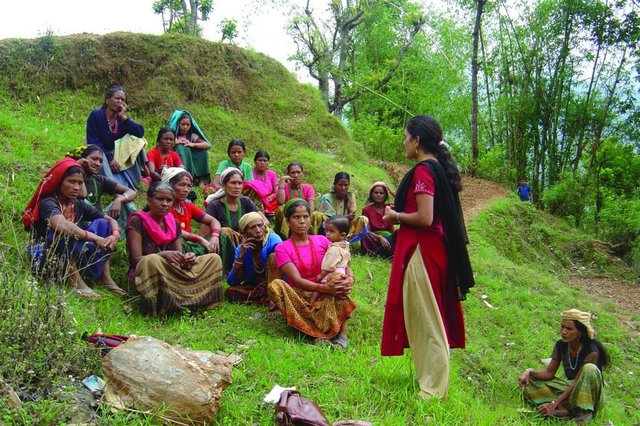
Farmer-led experimentation [尼泊尔]
Participatory technology testing and adaptation through farmer-led experiments
- 编制者: Richard Allen

Farmer-to-farmer diffusion [尼泊尔]
Wider diffusion of sustainable soil management technologies through a demand responsive farmer-to-farmer diffusion approach
- 编制者: Richard Allen
2. SLM技术的说明
2.1 技术简介
技术定义:
Improved compost preparation using a range of biomass and waste to produce high value fertiliser
2.2 技术的详细说明
说明:
Compost can be prepared from a wide range of organic materials including dead plant material such as crop residues, weeds, forest litter, and kitchen waste. Compost making is an efficient way of converting all kinds of biomass into high value fertiliser that serves as a good alternative to farmyard manure, especially for crop-growing households without livestock. The compost is often mixed with forest soil, ripe compost from the previous batch, or even a small amount of animal dung as a starter for the decomposition process. The mix of materials determines the quality of the final compost as much as the management of the composting process. Nitrogen-rich fresh materials such as legume residues and many types of weeds and shrubs are mixed with carbon-rich forest litter and cereal residues. Small amounts of wood ash, lime, or mineral fertiliser can help increase or balance the overall nutrient content of the compost.
The compost needs to be turned every 30-50 days depending on the mix and the outside temperature. It should be protected from direct sunlight, rainfall and runoff so as to reduce volatilisation and leaching of nutrients. The material must remain moist at all times to avoid slowing down decomposition and hindering the efficiency of the micro and macro-organisms involved in decomposition. Heaping the compost or collecting the material in a pit helps the compost to reach the temperatures needed (700C) to destroy pests and weeds.
Once the compost is well decomposed and has an earthy smell, it can be applied directly or stored for later application. It can be applied as a crop fertiliser in rows or to individual plants for improving general soil fertility and organic matter content, thus improving the soil structure and its water holding capacity.
2.3 技术照片
2.5 已应用该技术的、本评估所涵盖的国家/地区/地点
国家:
尼泊尔
有关地点的进一步说明:
Midhills districts of Nepal
Map
×3. SLM技术的分类
3.1 该技术的主要目的
- Improve compost production
3.2 应用该技术的当前土地利用类型

农田
- 一年一作
注释:
Major land use problems (compiler’s opinion): Intensifying cultivation practices with either 1) the inadequate application of fertilisers leading to a decline in soil fertility and the mining of soil nutrients or 2) the application of too much fertiliser causing environmental problems through excessive leaching, and losses of fertiliser in surface runoff and consequent eutrophication or nitrification of streams, ponds or groundwater.
3.5 该技术所属的SLM组
- 土壤肥力综合管理
- 废物管理/废水管理
3.6 包含该技术的可持续土地管理措施

管理措施
- M7:其它
3.7 该技术强调的主要土地退化类型

化学性土壤退化
- Cn:肥力下降和有机质含量下降(非侵蚀所致)
3.8 防止、减少或恢复土地退化
具体数量名该技术与土地退化有关的目标:
- 减少土地退化
4. 技术规范、实施活动、投入和成本
4.1 该技术的技术图纸
技术规范(与技术图纸相关):
Layering of the different materials in a compost pit
Note: This is just an example and need not be followed exactly. The important aspects are:
- the need for a starter such as forest soil or manure
- place weeds in the centre of the pit so that they are fully decomposed
- cover dry materials with moist material and material that only decays slowly with easily decaying material.
The pit can be 1 to 2m in diameter and about 1m deep. The size depends on the available biomass for composting and the amount of compost required.
Technical knowledge required for field staff / advisors: low
Technical knowledge required for land users: low
Main technical functions: increase in soil fertility and productivity, increase in soil organic matter content, improvement in physicalsoil conditions, increase in soil water holding capacity
4.2 有关投入和成本计算的一般信息
具体说明成本计算所用货币:
- 美元
注明雇用劳工的每日平均工资成本:
2.00
4.3 技术建立活动
| 活动 | 时间(季度) | |
|---|---|---|
| 1. | Dig a 1-2m diameter and 1m deep pit using a spade or shovel | |
| 2. | Collect crop residues, grass, tree leaves, ash, lime, and animal urine | |
| 3. | Put a layer of ash at the bottom of the pit followed by tree leaves, grass, crop residues, and a layer of forest soil (as it contains the necessary microorganisms – bacteria, fungi, etc. – and quickens the decomposition process) | |
| 4. | Add more tree leaves, crop residues, and grass until the pit is full and contains a healthy mixture of dry and fresh/moist materials | |
| 5. | Cover the compost heap with a fi ne layer of ash or mud and a cap of |
4.4 技术建立所需要的费用和投入
| 对投入进行具体说明 | 单位 | 数量 | 单位成本 | 每项投入的总成本 | 土地使用者承担的成本% | |
|---|---|---|---|---|---|---|
| 劳动力 | Preparing compost pit | Persons/day | 2.0 | 2.0 | 4.0 | 100.0 |
| 技术建立所需总成本 | 4.0 | |||||
| 技术建立总成本,美元 | 4.0 | |||||
4.5 维护/经常性活动
| 活动 | 时间/频率 | |
|---|---|---|
| 1. | Dispose of domestic and household wastewater and cattle urine in the pit to keep it moist (but not saturated/soaked) until it is fully decomposed. | |
| 2. | The compost needs to be turned every 30-50 days depending on the mix and the outside temperature. | |
| 3. | Depending on the location, it takes about 3-6 months for the compost to be fully decomposed. |
4.6 维护/经常性活动所需要的费用和投入(每年)
| 对投入进行具体说明 | 单位 | 数量 | 单位成本 | 每项投入的总成本 | 土地使用者承担的成本% | |
|---|---|---|---|---|---|---|
| 劳动力 | Maintaining compost | Persons/day | 1.0 | 2.0 | 2.0 | 100.0 |
| 技术维护所需总成本 | 2.0 | |||||
| 技术维护总成本,美元 | 2.0 | |||||
注释:
Cost as in January 2007
5. 自然和人文环境
5.1 气候
年降雨量
- < 250毫米
- 251-500毫米
- 501-750毫米
- 751-1,000毫米
- 1,001-1,500毫米
- 1,501-2,000毫米
- 2,001-3,000毫米
- 3,001-4,000毫米
- > 4,000毫米
有关降雨的规范/注释:
Annual rainfall: Also 2000-3000 mm
农业气候带
- 潮湿的
Thermal climate class: subtropics
5.2 地形
平均坡度:
- 水平(0-2%)
- 缓降(3-5%)
- 平缓(6-10%)
- 滚坡(11-15%)
- 崎岖(16-30%)
- 陡峭(31-60%)
- 非常陡峭(>60%)
地形:
- 高原/平原
- 山脊
- 山坡
- 山地斜坡
- 麓坡
- 谷底
垂直分布带:
- 0-100 m a.s.l.
- 101-500 m a.s.l.
- 501-1,000 m a.s.l.
- 1,001-1,500 m a.s.l.
- 1,501-2,000 m a.s.l.
- 2,001-2,500 m a.s.l.
- 2,501-3,000 m a.s.l.
- 3,001-4,000 m a.s.l.
- > 4,000 m a.s.l.
关于地形的注释和进一步规范:
Slopes on average: Also moderate (6-10%), rolling (11-15%) and hilly (16-30%)
Landforms: Also footslopes
Altitudinal zone: Also 1000-1500 m a.s.l., 1500-2000 m a.s.l. and 2000-2500 m a.s.l.
5.6 应用该技术的土地使用者的特征
生产系统的市场定位:
- 生计(自给)
- 商业/市场
个人或集体:
- 个人/家庭
说明土地使用者的其他有关特征:
Off-farm income specification: In most farm households, off-farm income plays at least a minor and increasingly a major role. Occasional opportunities for off-farm income present themselves in the form of daily labour wages. Some households’ members receive regular salaries, whilst an increasing number of Nepalis are working in India, the Middle East, Malaysia, and elsewhere and sending remittance incomes home.
5.7 应用该技术的土地使用者使用的平均土地面积
- < 0.5 公顷
- 0.5-1 公顷
- 1-2 公顷
- 2-5公顷
- 5-15公顷
- 15-50公顷
- 50-100公顷
- 100-500公顷
- 500-1,000公顷
- 1,000-10,000公顷
- > 10,000公顷
5.8 土地所有权、土地使用权和水使用权
土地所有权:
- 个人,未命名
- 个人,有命名
土地使用权:
- 租赁
- 个人
注释:
Sharecropping between owner and tenant
6. 影响和结论性说明
6.1 该技术的现场影响
社会经济效应
收入和成本
农业投入费用
注释/具体说明:
Reduced expenses on chemical fertilisers
工作量
注释/具体说明:
Preparation of compost is labour intensive
生态影响
其它生态影响
Soil fertility
Organic crop production
Application of fertilizer
6.2 该技术的场外影响已经显现
地下水/河流污染
注释/具体说明:
Reduction of nutrient influx into water bodies
Dependence on external inputs
6.4 成本效益分析
技术收益与技术建立成本相比如何(从土地使用者的角度看)?
短期回报:
积极
长期回报:
积极
技术收益与技术维护成本/经常性成本相比如何(从土地使用者的角度看)?
短期回报:
积极
长期回报:
积极
注释:
The high cost of mineral fertilisers means that the establishment costs are soon recovered. In the long-term, a major reduction in costs leads to large benefits.
6.5 技术采用
注释:
Comments on spontaneous adoption: About 30% of the participants of SSMP activities related to compost making, and about 20% of farmers that were
not part of the programme have adopted the technology.
6.7 该技术的优点/长处/机会
| 编制者或其他关键资源人员认为的长处/优势/机会 |
|---|
|
The use of compost reduced the need for mineral fertiliser thus reducing production costs and outside dependence How can they be sustained / enhanced? Further promote the technology to increase this impact |
|
Compost making does not require any livestock How can they be sustained / enhanced? Its low cost and use of local materials makes it the fertiliser of choice for poor households |
| In-situ composting saves labour involved in transporting compost to the fields |
6.8 技术的弱点/缺点/风险及其克服方法
| 编制者或其他关键资源人员认为的弱点/缺点/风险 | 如何克服它们? |
|---|---|
| The preparation of compost is not appropriate for commercial use (except in nurseries) | Compost improvement should go hand-in-hand with promoting alternatives for the other requirements |
| Compost requires a large amount of biomass which may otherwise be needed for fuel, fodder, or animal bedding |
7. 参考和链接
7.1 信息的方法/来源
7.2 参考可用出版物
标题、作者、年份、ISBN:
STSS; SSMP (2001) Farmyard Manure and Compost Management (in Nepali). Kathmandu: Soil Testing Services Section, Department of Agriculture andSustainable Soil Management Programme
可以从哪里获得?成本如何?
SSMP
链接和模块
全部展开 全部收起链接

Farmer field schools on integrated plant nutrient systems [尼泊尔]
Participatory and collaborative learning through the farmer field school approach
- 编制者: Richard Allen

Farmer-led experimentation [尼泊尔]
Participatory technology testing and adaptation through farmer-led experiments
- 编制者: Richard Allen

Farmer-to-farmer diffusion [尼泊尔]
Wider diffusion of sustainable soil management technologies through a demand responsive farmer-to-farmer diffusion approach
- 编制者: Richard Allen
模块
无模块


